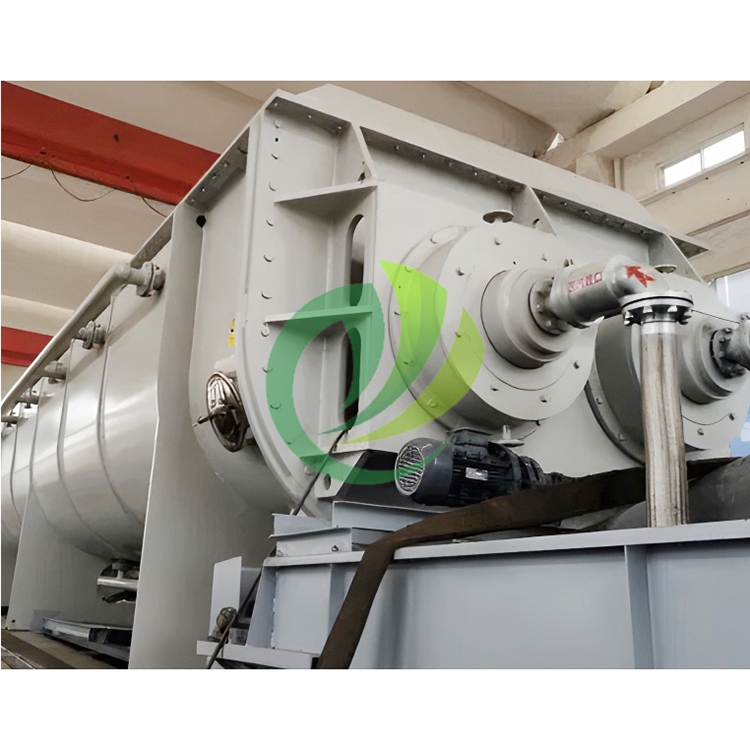Low
Maintenance Sludge paddle dryer, Energy Saving Sludge
Paddle Dryer, and High Performance Sludge Paddle Dryer are advanced solutions designed to efficiently process sludge in various industrial applications. These systems are engineered to reduce moisture content while maintaining the integrity of the material, ensuring optimal performance and minimal operational disruption. Whether used in
Wastewater treatment facilities, chemical processing plants, or food manufacturing units, these dryers provide a reliable and cost-effective method for sludge management. The primary function of a Sludge Paddle Dryer is to remove excess water from sludge through direct heat transfer and mechanical agitation. Unlike traditional drying methods that may rely on high energy consumption or inefficient processes, these dryers utilize a combination of thermal conduction and paddle movement to ensure even drying across the entire volume of material. This results in a more uniform final product with reduced energy requirements and
lower maintenance needs. 
Key characteristics of the Low Maintenance Sludge Paddle Dryer include durable construction, easy access for cleaning and inspection, and automated control systems that monitor temperature, pressure, and moisture levels. The Energy Saving Sludge Paddle Dryer is specifically designed to minimize power usage without compromising efficiency, making it an ideal choice for companies looking to reduce their environmental footprint and operating costs. The High Performance Sludge Paddle Dryer, on the other hand, is built to handle large volumes of sludge under demanding conditions, ensuring consistent output and long-term reliability. In terms of detailed description, these dryers operate by feeding wet sludge into a rotating cylindrical chamber equipped with paddles that move the material along the length of the dryer. Heat is applied either through steam, hot water, or electric heating elements, depending on the system configuration. As the sludge moves through the chamber, the paddles continuously mix and spread the material, maximizing contact with the heated surfaces. This ensures efficient evaporation and a final product with controlled moisture content, suitable for further processing or disposal. The use of Sludge Paddle Dryers is particularly beneficial in environments where space is limited or where continuous operation is required. They can be integrated into existing waste treatment systems or installed as standalone units, offering flexibility in design and application.
Additionally, their compact structure reduces the need for extensive infrastructure, making them a practical choice for both new and retrofit projects. These dryers are commonly employed in municipal wastewater treatment plants, where they help in reducing the volume of sludge before landfilling or incineration. In the food industry, they are used to process organic waste, turning it into a stable, nutrient-rich material that can be used as fertilizer. Chemical and pharmaceutical companies also benefit from these dryers when handling by-products that require dehydration for storage or transportation. User feedback has consistently highlighted the advantages of using these dryers, including improved efficiency, reduced downtime, and lower maintenance costs. Many operators have noted that the low maintenance nature of these systems allows for longer periods between servicing, which translates to increased productivity and fewer operational interruptions. The energy-saving features have also been praised for contributing to overall sustainability efforts, aligning with global initiatives to reduce carbon emissions and resource consumption.
Common questions about Sludge Paddle Dryers often revolve around installation, maintenance, and performance. Users frequently ask how these systems compare to other types of dryers, such as rotary drum or fluidized bed dryers. While each system has its own set of benefits, Sludge Paddle Dryers are generally considered more energy-efficient and easier to maintain, especially when dealing with thick or viscous materials. Another common concern is the initial investment cost, but many users find that the long-term savings in energy and maintenance make the purchase worthwhile. It is also important to note that the effectiveness of a Sludge Paddle Dryer depends on several factors, including the type of sludge being processed, the desired moisture level, and the available heat source.
Proper selection and customization of the system can significantly enhance its performance and longevity. Regular monitoring and adherence to manufacturer guidelines are essential to ensure optimal operation and prevent potential issues. Overall, the Low Maintenance Sludge Paddle Dryer, Energy Saving Sludge Paddle Dryer, and High Performance Sludge Paddle Dryer represent a significant advancement in sludge processing technology. Their ability to deliver consistent results, reduce operational costs, and support sustainable practices makes them a valuable asset in a wide range of industries. Whether the goal is to improve efficiency, meet regulatory standards, or contribute to environmental conservation, these dryers offer a reliable and effective solution.
